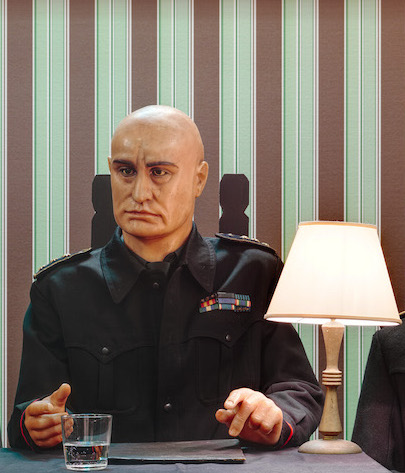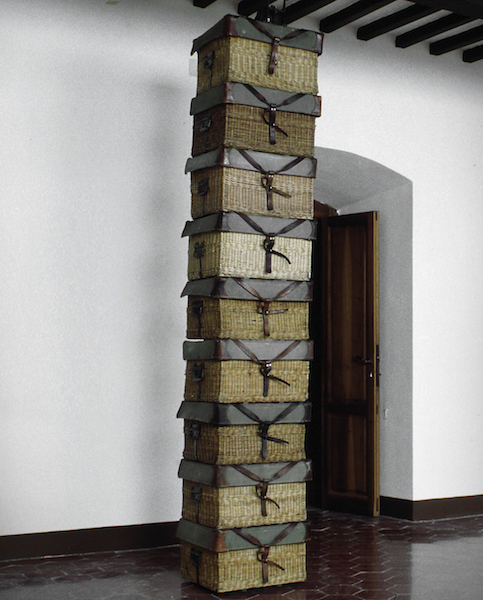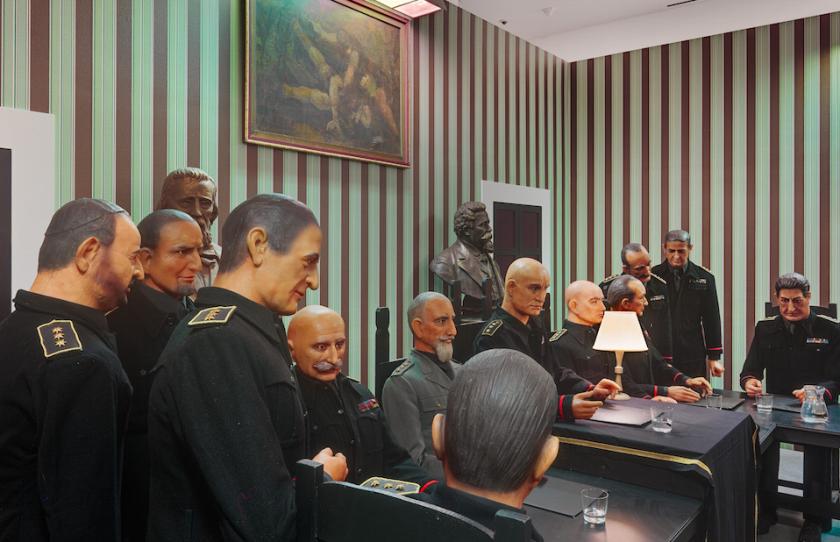Following his inclusion in this year’s Venice and Istanbul biennials, Italian artist Fabio Mauri has leapt into the limelight. He is from the same generation as Mario Merz; but whereas Merz and his Arte Povera colleagues have long since enjoyed an international reputation for work which features non-art materials in a raw state (hence the name "Poor Art"), Mauri has languished in relative obscurity – until now, that is.
Oscuramento, his first solo show in London for 20 years, provides the chance to catch up; but there is a problem – how to contextualise work which feels dated, because it was made many years ago, and how to engage a London audience in historical events that seem remote, even though they drastically shaped the lives of our forebears? I’m talking about the Second World War, which began when Mauri was 13 and became a life-long obsession (he died in 2009), but which we rarely consider from an Italian perspective.
 Dominating the exhibition is Oscuramento – Il Gran Consiglio (Darkening – The Grand Council), an installation made in 1975 which tackles an episode in Italian history that may not be familiar to British viewers (main picture and detail pictured right). Twenty-nine stoney-faced men in black uniforms sit or stand around a u-shaped table. At the head of the table is Benito Mussolini and this, the last meeting of the Grand Council of Fascism, was convened in Rome on 24th July 1943 to sanction his arrest.
Dominating the exhibition is Oscuramento – Il Gran Consiglio (Darkening – The Grand Council), an installation made in 1975 which tackles an episode in Italian history that may not be familiar to British viewers (main picture and detail pictured right). Twenty-nine stoney-faced men in black uniforms sit or stand around a u-shaped table. At the head of the table is Benito Mussolini and this, the last meeting of the Grand Council of Fascism, was convened in Rome on 24th July 1943 to sanction his arrest.
The installation is a faithful reconstruction of a tableau installed in the Wax Museum – Rome’s equivalent of Madame Tussaud’s – to which Mauri has added a soundtrack. The voices we hear are those of actors performing a radio dramatisation of the meeting, based on a recording of the actual event. Mauri is playing a complex double game. Rather than revisiting history itself, he is exploring the ways in which history is re-made and re-presented for future generations, often in a sanitised or heroised form.
The outside walls of the installation are hung with war photographs taken from English and German magazines which, he believes, distort the truth. But for those of us whose experience of the Second World War comes only second hand – via mediated accounts and images like these – we have nothing real against which to measure the validity of the pictures, so Mauri’s point gets lost.
In the 1959 Soviet film Ballad of a Soldier, directed by Grigori Chukhrai, the heroic dramatisation of events is far easier to spot, but Mauri complicates things by projecting the footage onto the back of a topless model, his point being that the effects of propaganda are unavoidable since we absorb it, unwittingly, through our skins. But using a woman’s body as a screen for the projection of illusions and fantasies is an idea so freighted with patriarchal overtones that it makes Mauri seem like a dinosaur from a pre-feminist era and, once again, his point is lost or, rather, overshadowed.
 One wall is lined with black rectangles of sheet steel against which are hung various items associated with war – a compass, lamp, gas mask, radio, walkie-talkie, paraffin stove, helmet and pilot’s hat. Elsewhere, the wickerwork and canvas trunks issued to Italian soldiers are piled into minimalist stacks (pictured left: Monument to Three Soldiers (Picnic or The Good Soldier), 1998). Each series aims to bring home the actuality of war, but the presentation is so neat and clean that it resembles a museum display rather than the wretched squalor of the battlefield.
One wall is lined with black rectangles of sheet steel against which are hung various items associated with war – a compass, lamp, gas mask, radio, walkie-talkie, paraffin stove, helmet and pilot’s hat. Elsewhere, the wickerwork and canvas trunks issued to Italian soldiers are piled into minimalist stacks (pictured left: Monument to Three Soldiers (Picnic or The Good Soldier), 1998). Each series aims to bring home the actuality of war, but the presentation is so neat and clean that it resembles a museum display rather than the wretched squalor of the battlefield.
I am reminded of how, despite their apparent neutrality, the neat displays at the Imperial War Museum seem to condone and glamorise war. Perhaps this is Mauri’s point; if so, it is too subtle to reverberate, especially when compared with installations made subsequently by artists such as Christian Boltanski. Addressing those murdered during the holocaust, Boltanski’s stacks of battered suitcases achieve a melancholy sense of loss and abandonment. By contrast, Mauri’s compositions seem elegantly like art.
Because we didn’t encounter Fabio Mauri’s work at the time that it was made, it has to take its chances, like history, and be revisited and judged by those who come afterwards – and cannot fully understand.









![SEX MONEY RACE RELIGION [2016] by Gilbert and George. Installation shot of Gilbert & George 21ST CENTURY PICTURES Hayward Gallery](/sites/default/files/styles/thumbnail_125_x_125_/public/mastimages/Gilbert%20%26%20George_%2021ST%20CENTURY%20PICTURES.%20SEX%20MONEY%20RACE%20RELIGION%20%5B2016%5D.%20Photo_%20Mark%20Blower.%20Courtesy%20of%20the%20Gilbert%20%26%20George%20and%20the%20Hayward%20Gallery._0.jpg?itok=3oW-Y84i)





Add comment